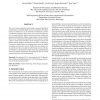Free Online Productivity Tools
i2Speak
i2Symbol
i2OCR
iTex2Img
iWeb2Print
iWeb2Shot
i2Type
iPdf2Split
iPdf2Merge
i2Bopomofo
i2Arabic
i2Style
i2Image
i2PDF
iLatex2Rtf
Sci2ools
VVS
1998
IEEE
1998
IEEE
Design of Accurate and Smooth Filters for Function and Derivative Reconstruction
The correct choice of function and derivative reconstruction filters is paramount to obtaining highly accurate renderings. Most filter choices are limited to a set of commonly used functions, and the visualization practitioner has so far no way to state his preferences in a convenient fashion. Much work has been done towards the design and specification of filters using frequency based methods. However, for visualization algorithms it is more natural to specify a filter in terms of the smoothness of the resulting reconstructed function and the spatial reconstruction error. Hence, in this paper, we present a methodology for designing filters based on spatial smoothness and accuracy criteria. We first state our design criteria and then provide an example of a filter design exercise. We also use the filters so designed for volume rendering of sampled data sets and a synthetic test function. We demonstrate that our results compare favorably with existing methods.
Derivative Reconstruction Filters | Most Filter Choices | Spatial Reconstruction Error | Visualization | VVS 1998 |
| Added | 05 Aug 2010 |
| Updated | 05 Aug 2010 |
| Type | Conference |
| Year | 1998 |
| Where | VVS |
| Authors | Torsten Möller, Klaus Mueller, Yair Kurzion, Raghu Machiraju, Roni Yagel |
Comments (0)

